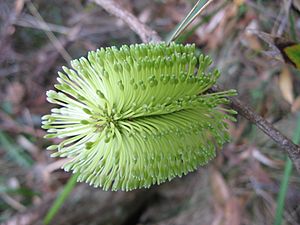White Mountain banksia facts for kids
Quick facts for kids White Mountain banksia |
|
|---|---|
 |
|
| A flower spike of the White Mountain banksia, ready to bloom. | |
| Scientific classification |
|
| Kingdom: | Plantae |
| Clade: | Tracheophytes |
| Clade: | Angiosperms |
| Clade: | Eudicots |
| Order: | Proteales |
| Family: | Proteaceae |
| Genus: | Banksia |
| Species: | |
| Subspecies: |
B. i. subsp. monticola
|
| Trinomial name | |
| Banksia integrifolia subsp. monticola K.R.Thiele
|
|
The Banksia integrifolia subsp. monticola, often called the White Mountain banksia, is a special type of Banksia integrifolia. It was first described in 1994. You can find this plant growing in the Blue Mountains and in northern New South Wales, Australia. This subspecies is known for having the biggest Banksia trees ever recorded!
Contents
What the White Mountain Banksia Looks Like
The White Mountain banksia is quite similar to another type, B. integrifolia subsp. integrifolia. However, there are a few key differences.
Leaves and Seed Pods
Its leaves are longer and narrower than those of its close relatives. The seed pods, called follicles, are tucked deeper into the old flower spike. These seed pods are also less likely to open on their own.
Flowers and Size
The flower spikes look a lot like those of the integrifolia subspecies. But in some places, like Barrington Tops National Park, they might have a pretty pink tint. This banksia holds the record for the largest Banksia trees. In Washpool National Park, some of these trees can grow as tall as 35 meters (about 110 feet)! That's like a 10-story building!
Frost Tolerance
The White Mountain banksia is also very special because it can handle cold weather and frost better than any other banksia tree.
How the White Mountain Banksia Got Its Name
For many years, people thought this banksia was just a mountain version of B. integrifolia subsp. compar. However, scientists later discovered it was actually more closely related to B. integrifolia subsp. integrifolia. They figured this out by looking at its physical features and its genes.
Discovery and Naming
In 1991, a scientist named Gwen Harden wrote about it in her book, Flora of New South Wales. She identified it as a separate subspecies but didn't give it a formal name. She just called it "Banksia integrifolia subsp. A".
Then, in 1994, Kevin Thiele officially confirmed it was a unique subspecies. He gave it the name Banksia integrifolia subsp. monticola. The word monticola comes from Latin and means "dweller in the mountains." This name perfectly describes where this banksia lives!
Where the White Mountain Banksia Grows
Unlike other types of B. integrifolia, the White Mountain banksia grows far away from the coast. You can find it inland in the Blue Mountains. Its habitat stretches between Mount Wilson and the New England National Park.
Preferred Environment
This banksia likes to grow in rich, fertile soils. These soils usually come from igneous rock, which is rock formed from cooled lava. It also prefers higher places, growing at altitudes above 650 meters (about 2,130 feet). Other banksia subspecies usually grow below 500 meters (about 1,640 feet) and in less fertile soils.
Why This Banksia Is Important
The White Mountain banksia is highly valued because it can survive in cold, frosty conditions. This makes it a great plant for gardens in cooler climates. It has even been planted in England!
Gallery
-
The natural home of Banksia integrifolia subsp. monticola near New England National Park.
See also
 In Spanish: Banksia integrifolia subsp. monticola para niños
In Spanish: Banksia integrifolia subsp. monticola para niños







